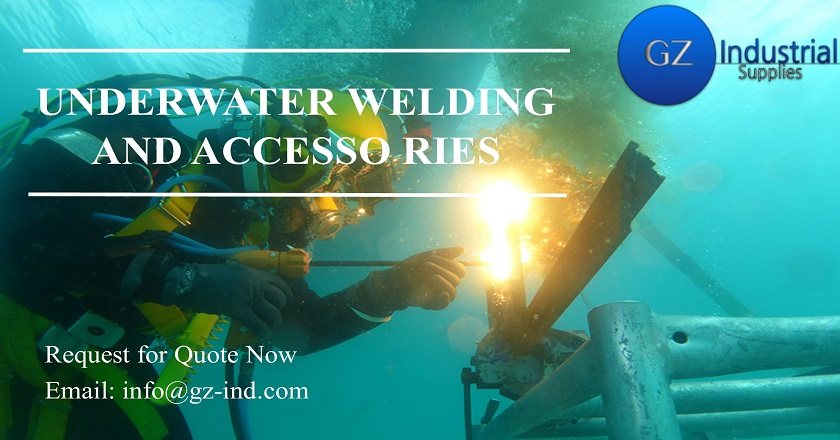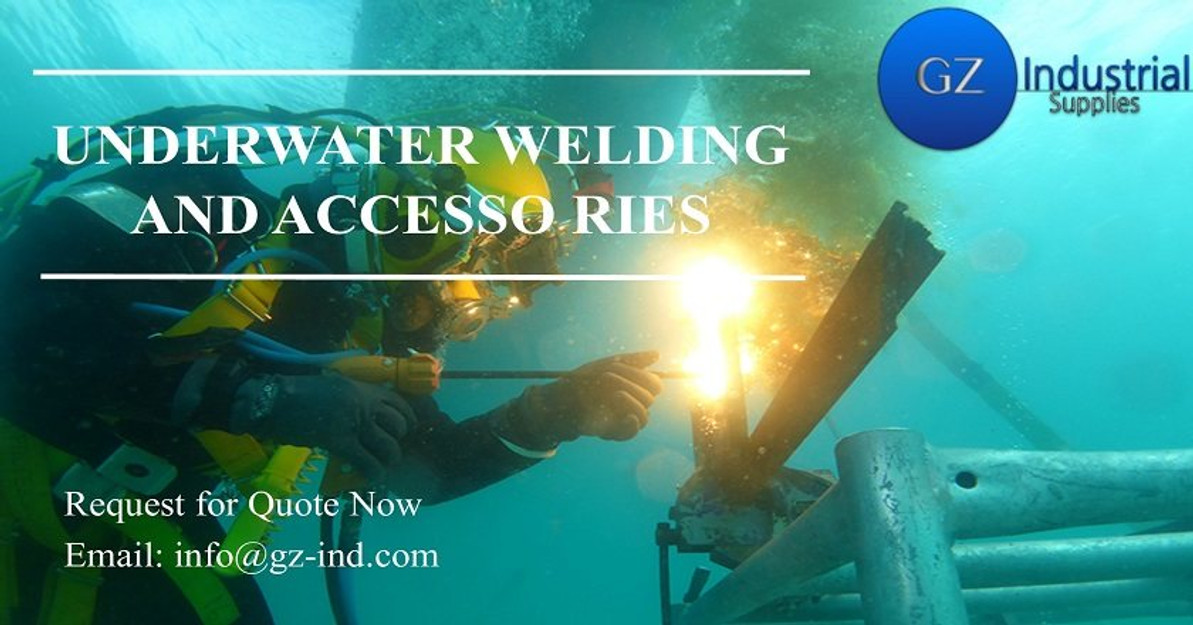UNDERWATER WELDING AND ACCESSORIES
UNDERWATER WELDING AND ACCESSORIES
The concept of underwater welding is quite interesting. And if you are looking for detailed information about the process, then you have landed on the right page.

Underwater welding is used in the repair of offshore structures and pipelines, ships, submarines, and nuclear reactors. Current techniques that are generally used are wet underwater welding and hyperbaric welding.Underwater welding work is needed when there are any structures or ships that require salvage. It is also needed whenever there are urgent repairs required. Apart from that, it comes in handy when there is a need of installation of new offshore drilling structures, subsea pipelines and hot taps, docks and harbor facilities, as well as modifications and additions to underwater structures.
Underwater welding has been around since the 1930s. It is widely used for maintaining the marine infrastructure that is present underwater. This kind of welding can be done in two ways either directly underwater, or by using a separate dry chamber.
Even though this job sounds pretty much the same as dry welding, it is far more dangerous. Even on dry land, welding techniques are quite risky. Doing the same procedures underwater only adds to that risk. That is why to be an underwater welder; a lot of requirements have to be fulfilled in order to ensure safety to all stakeholders.
PROCESSES OF UNDERWATER WELDING
Underwater welding can mainly be done in two ways, wet or dry. Each of these processes is described below:
1. Wet Welding
In wet welding, the diver does the job directly underwater. No separate chamber is used here, which is why divers can roam around the welding area and work quite easily than they could if their movements were limited to the insides of a chamber. However, not all of wet welding is advantageous.
While wet welding, the diver has to ensure that all materials are waterproof and safe to use while exposed to water. One of the most commonly used wet welding techniques is the stick welding or the shielded metal arc welding.
In this technique, an electric arc is used between the electrode that the diver uses to weld metals together, and the metals he wants to weld.
To properly perform the welding job, the diver first needs to assess his surrounding areas and make sure there are no safety hazards nearby. He should also steer away from any populated areas underwater. Then he should proceed to weld.
ADVANTAGES OF WET WELDING
- It is not expensive.
- No hassle of constructions.
- Welders can access the area with ease
2. Dry Water Welding
Dry water welding is a common form of underwater welding and preferred more over wet welding. It is usually done in a chamber placed underwater, so that the welder stays dry and can work with more precision. The chamber is filled with gases instead of water, thus creating a dry environment.
There are mainly two types of dry water welding, Cofferdam and Hyperbaric.
Cofferdam Welding
In this technique, a chamber is fixed and sealed around the welding area. The water is flushed out mainly by using valves.
Hyperbaric Welding
To perform this procedure, first, a chamber is placed around the structure that has to be welded. The chamber is then sealed, and all the water is replaced with a mixture of gases (usually helium and oxygen)
The pressure is maintained at such a level that the welder or the team of welders do not feel any decompression sickness. Other team members control fans to fill the chamber with clean air.
Welders usually use one of four techniques to dry water weld. These techniques are – Pressure Welding, Habitat Welding, Dry Chamber Welding, and Dry Spot Welding. Each technique is used for a different chamber size, which again depends on the structure that needs to be welded.
Although dry water welding minimizes the risk of welding underwater and gives the welders the option to work with more precision and accuracy, it is not always feasible. Creating a chamber, sealing it, replacing the water with gas, all these procedures are expensive and cannot always be done. In such cases, wet welding is the only option left.
ADVANTAGES OF DRY WATER WELDING
- It is less risky.
- The job can be done more accurately.
REQUIREMENTS FOR UNDERWATER WELDING
Underwater welding follows the basics of dry water welding. But as you can see, it is far more complex in various ways. Therefore, the requirements that need to be fulfilled before getting into this job are also very extensive.
First of all, you need to learn the basics of welding. You can do this by getting enrolled in a school or training program designed for this. After this, you need to learn commercial diving, which differs a lot from normal diving. When this step is completed, you will have to proceed to take an underwater welding course, which can take around seven months. Only after finishing all these procedures will you be ready to partake a job in underwater welding.
UNDERWATER WELDING EQUIPMENT
Every welding job is quite different. Their tools and soot have to be versatile and can take a great abuse. Because many underwater welders weld the topside, it is crucial to understand the way their tools work differently in marine environs.
To weld the underwater properly, the commercial diver requires five major tools;
- Power supply
- Stinger
- Electrodes
- Diving suit
- Accessories
- Diving helmet
ACCESSORIES OF UNDERWATER WELDING
Welders require necessary attachments and accessories on their job. They include;
Diving Knife
Just the way the whip is crucial to Indiana Jones so is the knife to the welder diver. It is an essential tool for many situations, whether they want to cut in the project material, free themselves from entanglement, or wedge opens a door. The diving knife does this job.
Umbilical cord
This is the place where the gas gets pumped to and from the surface to the welder.
Harness
This is crucial to keep the diver buoyant and in one area while doing her or his work.
Compressor and Gas Panel
A team that is qualified monitors the gauges of gas and maintains a steady supply of air that is coming to the underlying diver. Divers monitor them directly. Many of them employ low-pressure gas because of low maintenance and an unlimited supply of air.
Bailout Gas
Utilized for emergencies, this gas gets carried by divers as a secondary source of gas supply in case the SSA equipment fails. It appears in the form of minor scuba tanks.
Knife Switch
The knife switch is not similar to the diving knife. It is utilized while using underwater electric equipment when welding. Constructed like a simple lever, it controls electricity floor from the topside to provide power to your tools.
Underwater Welding Machine
Current and amperage matters when it comes to the welding machine. Counter to many topside processes of welding, controlling marine welding equipment works well in partnership with the control team and the divers below the boat. Immediately before the diver starts welding, she or he will communicate through the radio towards the control team.
This provides a signal to turn underwater welding machines to the right amperage. The required power is dependent on the electrode size. Since the majority of the weld is done on top, a few companies formulate welding machines that are specifically made for underwater welding.
Kindly contact GZ Industrial Supplies Limited for more information or support for underwater welding and accessories. Thanks for reading this article. We hope that you digest the required knowledge about underwater welding and accessories inside this post.
Recent Posts
-
Press Release: Same Great Lube, Less Waste: Lubemax 50:50 makes the Switch to Sustainable Packaging
In a move towards environmental responsibility, Epoxy Oilserv Nigeria Limited is proud to announce t …Apr 23, 2024 -
Top 8 Generators Recommended by Professionals in Nigeria (Reviews)
Generators can keep your home or business running with your essential equipment until the power is b …Apr 23, 2024 -
Transformer Safety: Preventing and Managing Common Hazards
Transformers are critical components in the electrical distribution system, handling high volt …Apr 23, 2024



